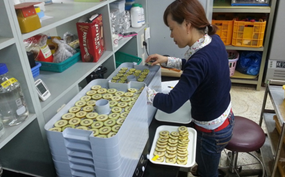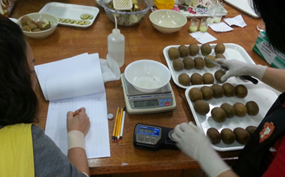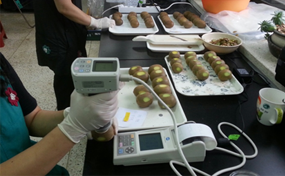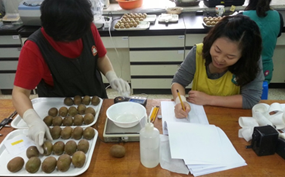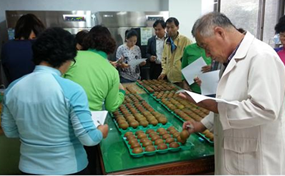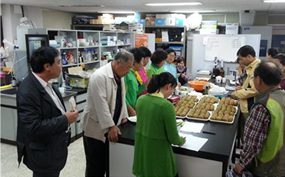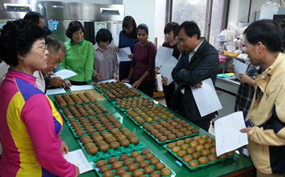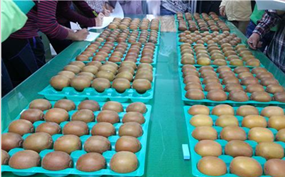Research and development
HAEGEUM GOLD KIWI continues to evolve.
Research and development
-
95~96
- In the Kiwifruit market of the whole world, Green kiwi fruit accounted for 100%.
- Gold Kiwi Fruit was collected and selected in China in 70s and 80s. Was not commercialized.
- Zespri Gold began to be distributed to farms in New Zealand in 1998.
- Korean Kiwi fruit producers and consumers never imagined gold kiwi fruits.
- Traditionally, Kiwi fruits must be sour, sweet, and green.
-
After the final selection
- Passed the new varieties selection council to foster duty by the Rural Development Administration (2006)
- Was finally named ‘Haegeum’
- Registration of variety name, report of production and sales, and application for protection of new varieties
- Began to be supplied to persons who want to cultivate after the application.
- New variety supply project by the Rural Development Administration on December 2008. Carried out by Jeonnam Peach Orchards.
- Variety protection registration (May 2010)
Quality improvements
- Appearance is excellent and uniform.
- High cultivation safety
- Easy revelation of the gold color in fruit flesh
- Cultivator-friendly
- Harvest time is fast as the middle and last parts of October
- Can be harvested before the first frost of the season
- New shoot damage can be avoided before and after May 12 in the full bloom stage.
Basic characteristics of growth and development of plant bodies
| Major cultivation regions and growth and development period | Growth and development for about 150 days after the full bloom stage in the middle of May in Jeonnam, Gyeongnam, and the Southrn coast of Kroea |
|---|---|
| Harvest maturity | Medium variety, The middle and last parts of October, (Based on Heaenam, Masan, and Sani-myeon). Very different according to weather conditions and cultivation environment |
| Optimal temperature of growth and development | The regions that is above -5℃ in winter season is stable. |
| Tree performance and water energy | Strong and energetic growth, differentiation of flower buds is uniform and well done. |
| Fruiting weiser proyent (%) | 95 to 100% (*Hayward 60 to 70%) |
| Ability to handle the wind | Mesophyll is thick and strong on the wind because leaves are small. |
Quality improvement of fruits
| Eating quality | Less sour, high in sugar, and flavor and eating quality is excellent. (*Acidity after-ripening : 0.5 to 0.6%) |
|---|---|
| Fruit flesh color | Yellow |
| Shape and form | Oval type, No protrusion in fruit apex (* Haute 16A Projected.) |
| Weight(g) | 90-110, Maximum 130 (*Haute 16A: 80-100) |
| Sugar content after ripening (˚Bx) | 15-17, Maximum 18.5(After ripening) |
| Dry weight (%) | 16-19 |
Quality standard of minimum harvest
| Chromaticity in fruit | The average is below 103 degrees, or the whole fruits are below 109 degrees |
|---|---|
| Hardness | The average is more than 4.0kgf. |
| Dry weight | The average is more than 16%. |
| Sugar content in harvest | Sugar content in harvest: The average is more than 8%. |
Quality inspection of co-shippers - Chromaticity, dry weight, hardness, sugar content – passed the minimum standards and notified farms of the possibility of harvest.
Appearance evaluation
Nutritional values of Haegeum Gold Kiwi Fruit (Based on fruits of 100g)
Source) The Fruit Tree Research Center of the Jeonnam Agricultural Research & Extension Services.
| Calories kcal | Dietary fiver g | Protein g | Fat g | Calcium mg | Iron mg | Phosphorus mg | Potassium mg | Vitamin C mg | Polyphenol mg | β-Carotene mg | Antioxidation activity mg |
|---|---|---|---|---|---|---|---|---|---|---|---|
| 65 | 1.25 | 0.7 | 0.3g | 15.5 | 0.2 | 23.7 | 287.0 | 82.0 | 100.5 | 0.93 | 1.53 |

